
ℹ️ Information about Cao Bang
🚍 How to get to Cao Bang
☀️ Weather in Cao Bang
🏡 Accommodation in Cao Bang
🔍 Interesting sites in Cao Bang
📍 Map of interesting places
🎫 Book Tickets to Cao Bang
Quick answer: Cao Bang is a remote, mountainous province in northeast Vietnam, bordering China, known for its incredible landscapes, strong presence of ethnic minority cultures, and historical sites. With a population of around half a million and more than 30 ethnic groups, it’s becoming a rising tourism destination focused on nature, community travel and heritage.
At a glance:
- 📍 Location: Northeastern Vietnam, shares a border with China.
- 📐 Area: ~6,700 km².
- 👥 Population: ~570,000 (2025).
- 👲 Ethnic groups: Tay (~40.8%), Nung (~29.8%), Mông (~11.7%), Dao (~10.4%), plus others.
- 🏞️ Landscape: Mostly mountainous terrain with forests, rivers, and karst geology.
- 🎯 Tourism highlights: Ban Gioc Waterfall, Nguom Ngao Cave, Thang Hen Lake, Pac Bo historic site, and a UNESCO Global Geopark.
- 🌱 Culture & economy: Rich in ethnic culture, community tourism is growing, and local products like Shan Tuyet tea and herbal medicines are being promoted.
Last updated in November 2025
Discover the Untamed Beauty of Cao Bang:
-
- Cao Bang province (Cao Bằng) with its capital of the same name borders China on the east of northern Vietnam. There are approximately 550,000 inhabitants in this province. A lot of people are from the ethnic groups such as Tay, Nung, Dao and Hmong. Cao Bang province belongs to the one of the poorest region in the north of Vietnam, but nature is fascinating and you should definitelly visit this place if you are already in the north of Vietnam.
Practically the entire province of Cao Bang is dotted with hills and villages.
-
- Cao Bang town was damaged in the war with China in 1979 and has since been rebuilt. It lies at an altitude of 300m, so there is a very beneficial climate all through the year. In 2018, a big part of Cao Bang province was established like Non Nuoc Cao Bang Geopark, this is the second geopark in Vietnam after Dong Van Karst Global Geopark in Ha Giang. Non Nuoc Cao Bang Geopark covers a large area of Cao Bang province and if you want to explore this site, you should travel on motorbike, because travel by local bus it is not easy and sometimes not possible.
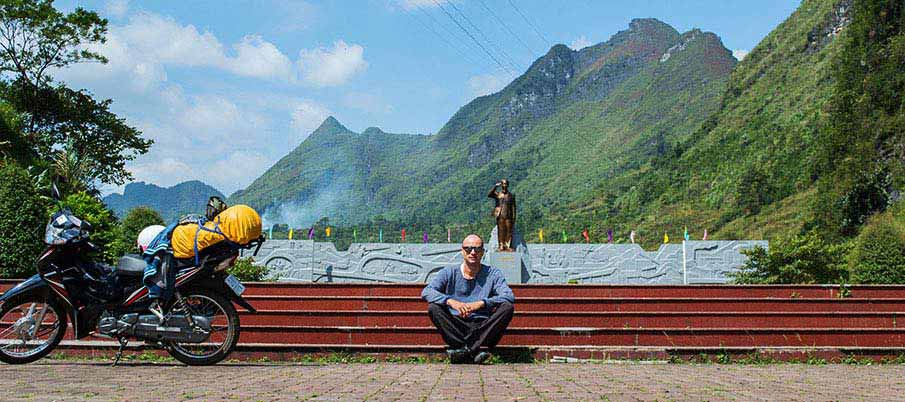
The area of Cao Bang is a little bit forgotten by foreign tourists.
-
- Cao Bang is mainly mountainous with spectacular scenery and good trails for trekking and exploring the ethnic minorities in the surrounding villages. In the winter snow fall is possible and there will be freezing conditions in the mountains of Cao Bang province, so be prepared with appropriate clothing.
- One of the most visited place is Ban Gioc Waterfall on the border with China and also beautiful Thang Hen Mountain Lake. The other beautiful places in Cao Bang are Ky Sam palace, Coi Bin monastery and various mountains passes and scenic views. Thang Hen Lake is now a popular tourist resort, visited mainly by Vietnamese.
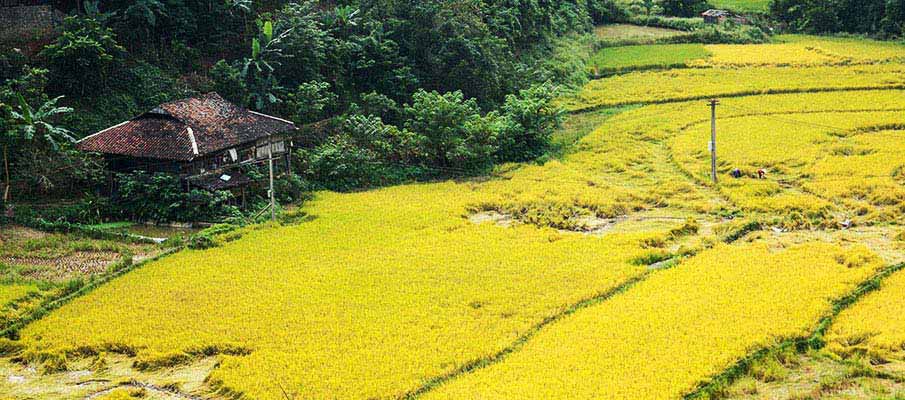
Cao Bang has several important points of historical significance.
-
- For example Pac Bo Historical Site (at the Bang Giang and Hien rivers). Coc Bo cave is the place where Ho Chi Minh established a revolutionary force in January 1941. In 1920, the area became an important cradle of the revolutionary movement in northern Vietnam.
- Pac Bo Historical Site include – Coc Bo cave, Lung Lan, Nguom Vai, the house’s floor of Mr. Ly Quoc Sung, Le Nin spring, Cac Mac mountain, Gooc Mu field, Na Chang, Khuoi Nam hut, memorial house of Ho Chi Minh president, etc. It is also very easy to get there by motorbike from Cao Bang town, road is in a good condition.
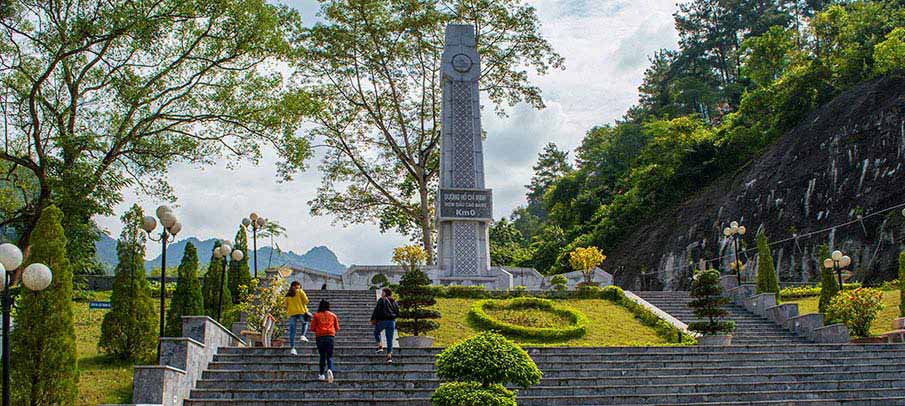
Cao Bang province will ofer various amazing sceneries almost everywhere.
-
- If you are traveling on a motorbike in Cao Bang, you have the advantage of being able to go outside the main road. However, not everywhere there are roads in a good condition, but these sceneries are beautiful, some of them you can find near the main roads, I highly recommend such places to visit.
- You should have a time, motorbike and self-determination. One of the most impressive area for me, the less visited place, but easily accesible by motorbike is – Phong Nam or Tra Linh and then the area around Ban Gioc Waterfall, Ban Lung. These places are ideal for visit if you are traveling on motorbike in this province.

Soc Ha in Ha Quang district – another spectacular views close to Pac Bo.
-
- Many visitors of the historical site Pac Bo, north of Cao Bang town, usually only visit this place. However, if you have a time and want to see an interesting agricultural area full of rice fields and beautiful mountain sceneries without tourists, I recommend to travel about 10 km west of Pac Bo to Soc Ha (Sóc Hà). This area consists of several smaller villages and lies practically on the border with China near the city of Pingmengzhen.
Accommodation in Cao Bang town (good reviews):
▶️ Cao Bang Eco Homestay
▶️ Jeanne Hotel
▶️ Max Boutique Hotel
▶️ Duong Ha Hotel
▶️ Primrose Homestay Cao Bang
▶️ RuBy Motel

Ban Gioc is the 4th biggest waterfall in the world, and leads over the boarder.
-
- Ban Gioc Waterfall is located 80 km north of Cao Bang town on the border with China. Ban Gioc Waterfall is over 200 m wide and the water falls from a height of 70m over 3 sections. In the sunlight you can watch the seven colour waterfall. The colour of the water depends on the weather in this area. You can ride on a boat (bamboo rafts) and watch the waterfall directly, it is fascinating.
Book a TOUR / ACTIVITY in Vietnam ➜
- This waterfall is the largest in Vietnam, but not the highest. Ban Gioc Waterfall is one of the top tourist and visited site in Cao Bang province. Recommended – rent a motorbike in Cao Bang town and travel on your own, road to the waterfall is in a good condition and it is not difficult.

Phat Tich Truc Lam Ban Gioc pagoda and the best spectular view at the waterfall.
-
- Phat Tich Truc Lam Ban Gioc pagoda is only about 500m from the Ban Gioc Waterfall and it is very easily accessible. Go up and you will be surprised by the fascinating view of the entire area by the waterfalls. Phat Tich Truc Lam pagoda was inaugurated in 2014 and it is a part of Cao Bang national tourist site and attracts many tourists (mainly Vietnamese) throughout the year. In my opinion, this is the best view to the area around Ban Gioc Waterfall.
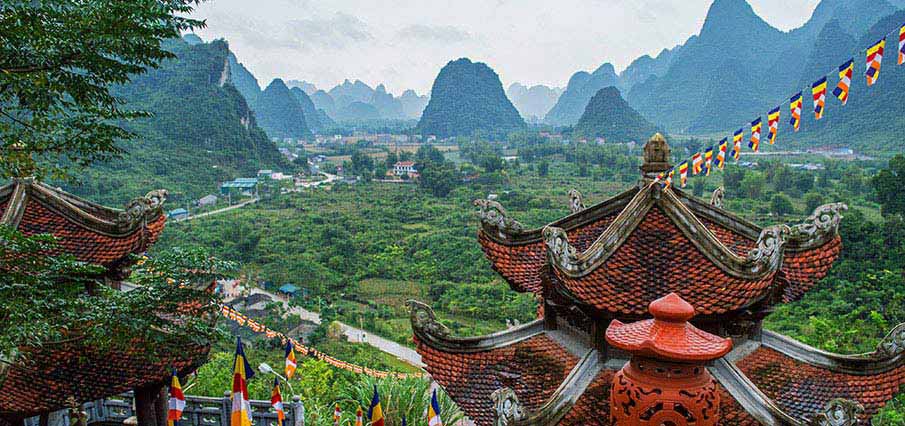
Nguom Ngao Cave is an amazing cave system, close to Ban Gioc Waterfall.
-
- Only about 4 km from the Ban Gioc Waterfall, you can visit one of the most interesting cave systems in Vietnam – Nguom Ngao. It is one of the largest caves in Cao Bang province and very easilly accesible. You come, buy ticket and you can go to the cave. Nguom Ngao Cave is about 1 km long for tourists (totally about 2 km), and you can see there some huge stalactites and go into the 100m high cave chamber.
- There are a few very large chambers and you should definitely visit this place, really stunning. In front of the cave you can buy some refreshments and there is also a parking lot. There are also some local small homestays nearby.
- Accommodation and homestays near the Nguom Ngao Cave and Ban Gioc Waterfall: Khuổi Ky Homestay and Mảy Linh Homestay Bản Giốc – a typical village homestays in nice area.
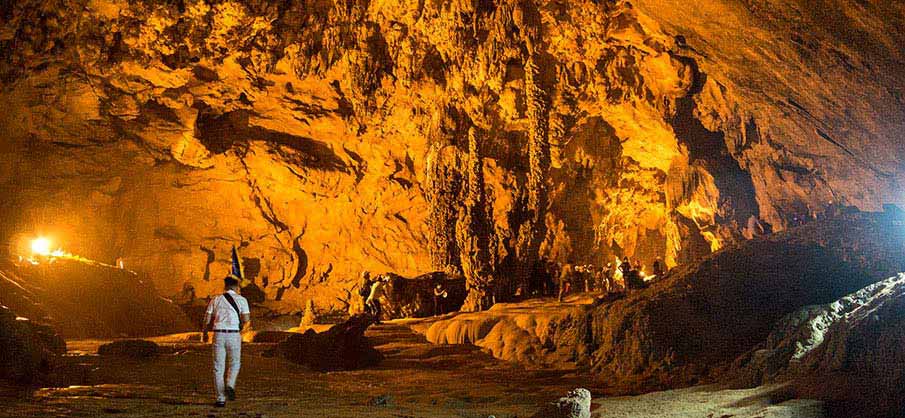
Only 20 km from Cao Bang town is the beuatiful Thang Hen mountain lake.
-
- Thang Hen Lake in Tra Linh District consists of 36 small natural lakes on the hill at a height of 1,000m above sea level. The lakes were formed in limestone formations. An unusual phenomenon of these lakes is that the water level moves like the tide of the sea.
- The lakes in Cao Bang form the rivers that feed Ban Gioc Waterfall. Thang Hen is also a tourist resort, in the season is visited mainly by vietnamese tourists, you can find there also restaurant and some homestays.
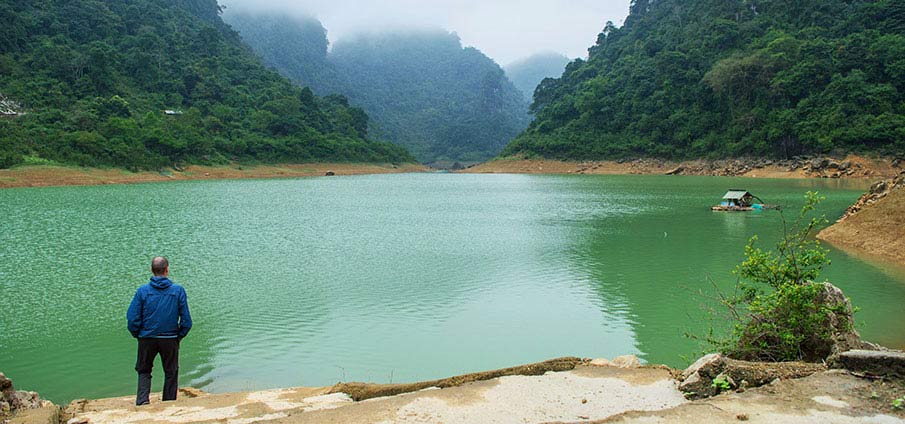
Bao Lac can be the first stop if you are traveling from Ha Giang to Cao Bang.
-
- Bao Lac is located in the far west of Cao Bang province, about 120 km from the city. If you travel from Ha Giang, it may be your first stop in Cao Bang province. This place definitely can not be described as tourist place, it has no top tourist spots. However, this may be an advantage, and what is not much touristy in Vietnam, sometimes it is most authentic.
- If you stay in Bao Lac longer, you can go to the beautiful area of Xuan Truong by motorbike. The whole area of Bao Lac is a place of different ethnic groups and minorities, for example, the Lo Lo and Mong ethnic groups.
- Accommodation in Bao Lac: Việt Hoàng hotel (a good reviewed hotel in the town) or Hotel Đức Tài.
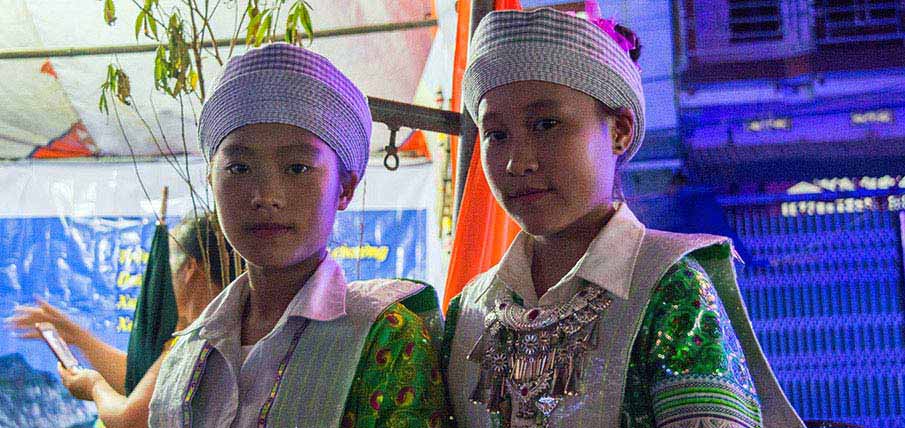
Xuan Truong – a rural village only about 25 km from Bao Lac.
-
- Cao Bang is a province where you can see and visit various ethnic rural villages, but lots of them are not easily accesible. So the best way how to see Cao Bang province is to travel by motorbike on your own.
- Travel by motorbike to Xuan Truong (20 km from Bao Lac) is not so hard, there is a good road and you will be traveling in very nice mountains area. This village is located in a nice valley surrounded by mountains. Inhabited mainly by ethnic people. The only way how to get there is to travel by motorbike and you will see Me Pia Pass (đèo Mẻ Pia).

Ba Be National Park is a good place for trekking and homestay accommodation.
-
- Ba Be National Park is located about 100 km west of Cao Bang town, it is already in Bac Kan province. It is a good place for trekking and exploring ethnic local minorities or visit Ba Be Lake. Visit some ethnic villages with residents who actually live here. A lot of residents are from the Dao and Tay ethnic group. Around Ba Be Lake there are several villages, with some smaller waterfalls and caves. There are plenty of precious and endangered species that inhabit this region. It is not a problem to stay in homestay, most of them are typical wooden cottages, you can book them here > Homestays in Ba Be National Park.
Ba Be National Park is a valuable natural heritage site of Vietnam.
-
- Ba Be Lake is composed from three interconnected lakes and its length is about 8 kilometers. You can try boating or bamboo rafts and there is an opportunity to explore local caves, with or without the boat. You can stay here in homestay accommodation with the local people and try very good local food. These homestay accommodation houses are adapted for travelers and tourists from Vietnam. You can also travel by bus or comfort limousine directly from Hanoi to Ba Be National Park > Book and buy bus tickets from Hanoi to Ba Be National Park.
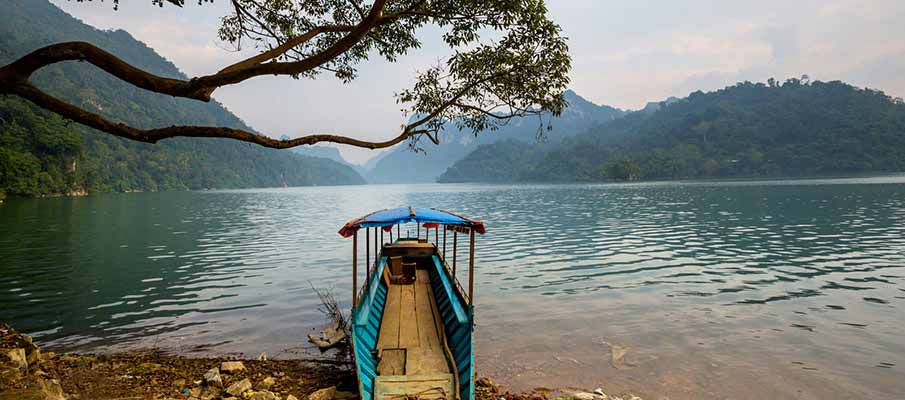
Ba Be National Park still holds its unique authentic look.
-
- A very good option is to try a homestay with the Tay ethnic residents in the village of Pac Ngoi. Pac Ngoi is a small village directly by Ba Be lake on the south side of the lake. There are about 30 original buildings of Tay ethnic residents on “stilts“ and there is also accommodation available. Accommodation costs approximately 100,000 Vietnamese dongs for one person.
Pac Ngoi village offers homestay with Tay ethnic residents.
-
- The locals are happy to show you their culture, customs, food offerings, or just sitting by the fire. This village is the best place to be in easy reach of Ba Be lake. For more information about the Tay ethnic group read the article – ethnic minorities of Vietnam.

🚍 How to get from Hanoi to Cao Bang:
From Hanoi to Cao Bang town by sleeper bus / minivan or taxi:
-
- there are some sleeper buses from Hanoi to Cao Bang
- there are mainly overnight sleeper tourist buses from Hanoi to Cao Bang
- bus tickets from Hanoi to Cao Bang costs about 15-25 USD
- travel by sleeper bus from Hanoi to Cao Bang takes about 7.5-10 hours
- bus companies from Hanoi to Cao Bang: VietNam Travel Bus, Thanh Ly, Khanh Hoan, Duc Duong Bus, Techbus VN, Grouptour, Vietnam Luxury Travel
- buses depart from various stations in Hanoi and arrive at various stations or stops in Cao Bang
- travel by private taxi/minivan from Hanoi to Cao Bang or Ban Gioc Waterfall costs about 120-275 USD/car
- Book and buy bus e-tickets from Hanoi to Cao Bang on 12go.asia ➜ or Baolau ➜
- Book private taxi/car from Hanoi to Ban Gioc Waterfall on 12go.asia ➜

🚍 How to get from Cao Bang to Ban Gioc Waterfall:
-
- The only way is to travel by bus or motorbike. There are some local buses in Cao Bang town, for a current schedule I recommend to ask at the bus station or at the hotel. If you can, rent a motorbike in Cao Bang town and travel and explore this very nice area on your own.
Where to rent a motorbike in Cao Bang?
-
- QT Motorbikes (from Ha Giang) opened in February 2019 their new branch in Cao Bang town (054 Cầu Bằng Giang). Reliable and very good company, operating also in Ha Giang, you can rent there a motorbike.
🚍 How to travel from Ha Giang to Cao Bang:
-
- there are 2 options how to reach Cao Bang from Ha Giang – bus/minivan or motorbike.
- the most beautiful travel route is from Ha Giang town to Dong Van town, Meo Vac, Bao Lac.
- there are mainly small local buses, cheap bus tickets, but travel by bus takes a lot of time.
- there is no train and there are no flights from Ha Giang to Cao Bang, Cao Bang has no airport
- read this article: How to reach Cao Bang from Ha Giang?
🚍 How to get from Cao Bang town to Ba Be National Park:
-
- There are 2 roads from the town of Cao Bang to the National park, it is about 130 km. From Cao Bang town some buses go to Phu Thong (ask in the hotel or at the bus station). In Phu Tong take a local bus to Cho Ra town, which is about 20 km. Cho Ra is about 10 km from Ba Be National Park. In Cho Ra take a mototaxi (Xe Om). If you have a motorbike, just look at the map, and go on one of the 2 main roads leading from the city of Cao Bang.
☀️ Weather in Cao Bang + The Best Time to Visit:
The weather in Cao Bang is characterized by two main seasons: the dry season and the rainy season. You can also check ➜ Current weather in Cao Bang, before you arrive to Cao Bang province.
-
- The dry season in Cao Bang typically runs from October to March, while the rainy season typically lasts from April to September. During the dry season, the weather is generally cool and dry, with average temperatures ranging from 15-20°C (59-68°F). The skies are usually clear and sunny, making it a great time to explore the natural beauty of the province, including its stunning mountain landscapes and waterfalls.
-
- In contrast, the rainy season in Cao Bang is characterized by high humidity and frequent rainfall. The average temperatures during this season range from 22-27°C (72-81°F), and the rainfall can be quite heavy, particularly in July and August. While the rainy season can make some parts of Cao Bang more difficult to access due to flooding, it can also be a great time to witness the lush greenery of the region and see the waterfalls and rivers at their fullest.
-
- The best time to visit Cao Bang really depends on your personal preferences and interests. If you prefer cooler, drier weather and want to explore the mountains and waterfalls, then the dry season is likely the best time for you to visit. However, if you don’t mind some rain and want to experience the full beauty of the region’s natural landscapes, then the rainy season may be a great time to plan your trip.
🏡 Accommodation in Cao Bang:
Cao Bang province offers a variety of accommodation options to suit different budgets and preferences. Cao Bang has a wide range of guesthouses, hotels or homestays, Trung Khanh District offers also various local homestays. Here are some of the most common types of accommodations in Cao Bang:
-
- Hotels: Cao Bang has a range of hotels that cater to different budgets and needs. Some of the hotels are located in the city center, while others are situated in more remote locations with stunning mountain views. The quality of hotels varies from basic guesthouses to mid-range hotels with modern amenities.
-
- Homestays: For a more authentic experience, travelers can opt to stay in a homestay, which is a type of accommodation where you stay with a local family in their home. This is a great way to experience the local culture and way of life, and many homestays also offer home-cooked meals and activities like trekking and farming.
-
- Guesthouses: Guesthouses are a more budget-friendly option compared to hotels, and they are a popular choice among backpackers and budget travelers. These guesthouses usually offer basic amenities like a bed, fan, and shared bathroom facilities.
-
- Resorts: For travelers looking for a more luxurious experience, there are several resorts located in Cao Bang. These resorts offer more upscale amenities like swimming pools, spas, and fine dining restaurants.
-
- Camping: For the adventurous traveler, camping is also an option in Cao Bang. Many of the national parks and scenic areas in the province allow camping, and there are also a few organized camping trips available.
➜ Accommodation in Cao Bang (hotels, homestay…) – Book Here
➜ 15 Best Hotels + Homestays in Cao Bang
| Hostels + Homestays in Cao Bang | Homestays in Ba Be National Park |
|---|---|
| Primrose Homestay | Hoàng Nguyên Homestay |
| Minh Hoang Hotel ★ | Hoa Sơn Homestay |
| Dương Hà Hotel ★ | Huyen Hao homestay |
| Jeanne Hotel ★ | Hoàng Chuyền Homestay |
| Khuổi Ky Homestay | Quynh Mai Homestay |
| Green Door house | Duy Tho Homestay |
🔍 Places of Interest in Cao Bang:
-
- Pac Bo Historical Site (Coc Bo cave – a place where Ho Chi Minh founded the revolutionary force)
(Pac Bo include Coc Bo cave, Lung Lan, Nguom Vai, the house’s floor of Mr. Ly Quoc Sung, Le Nin spring, Cac Mac mountain, Gooc Mu field, Na Chang, Khuoi Nam hut, memorial house of Ho Chi Minh president, etc.) - Relic of Heroic Martyr Kim Dong (near Pac Bo)
- Ban Gioc Waterfall (Detian Falls) + Nguom Ngao Cave
- Trúc Lâm Phật Tích Pagoda (near the Ban Gioc Waterfalls)
- Non Nuoc Cao Bang Geopark (geopark recognized in April 2018 by UNESCO)
- Phia Oac – Phia Den National Park (area at the town of Tinh Tuc in Nguyen Binh district)
- Phong Nam scenic area (Trung Khanh District)
- Thang Hen Lake + Resort (+Thác Nặm Trá)
- Bao Lam District (+Pac Miau town)
- Ma Phuc pass on the road to the Ban Gioc waterfalls
- Bao Lac + Xuan Truong
- Ky Sam palace
- Coi Binh Monastery
- Markets in Cao Bang town
- Me Pia Pass (đèo Mẻ Pia) in Xuan Truong (about 25 km from Bao Lac)
- National Park Ba Be in Bac Kan province (Dau Dang waterfall, other caves and local villages)
- homestays at the National Park Ba Be
- Pac Bo Historical Site (Coc Bo cave – a place where Ho Chi Minh founded the revolutionary force)
📍 Cao Bang + Ba Be Lake – tourist map:
❓ Frequently Asked Questions + Tips about Cao Bang:
1. How to book bus tickets or private car from Hanoi to Cao Bang?
2. How to search and book a tour or other activity in Vietnam?
-
- You can search and book a tour, tickets for attraction or other tourist activity in Vietnam online with KLOOK. There are various tours or motorbike trips in northern Vietnam.
3. How to move in Cao Bang province?
-
- The best way is to travel on motorbike or private transfer. IDP is necessary if you want to drive a motorbike in Vietnam. You can book your motorbike in Vietnam online with Bikesbooking. It is good to know, roads in Vietnam are dangerous, drive carefully and slowly, watch the traffic. There are also some local buses in Cao Bang province (eg. between Cao Bang and Ban Gioc…), but it is limited.
4. What is the travel time from Hanoi to Cao Bang?
-
- Travel by tourist bus from Hanoi to Cao Bang takes about 8-10 hours.
- Travel by private taxi / car from Hanoi to Cao Bang takes about 8 hours.
5. How much is the bus or taxi from Hanoi to Cao Bang?
-
- Travel by tourist bus or minivan from Hanoi to Cao Bang costs about $8-11/pp.
- Travel by private car from Hanoi to Ban Gioc Waterfall costs about $190-275/car.
6. Is there an airport and railway in Cao Bang province?
-
- No, Cao Bang has no airport and there is no railway in this province, travel by train is not possible.
7. How far is Cao Bang from Hanoi?
-
- Travel distance from Hanoi to Cao Bang town is about 300 km by road.
8. What are the must-visit attractions in Cao Bang?
-
- Cao Bang has several must-visit attractions, including Ban Gioc Waterfall, Nguom Ngao Cave, Phuc Sen Village, Pac Bo Cave, and Thang Hen Lake. Ban Gioc Waterfall, in particular, is a breathtaking natural wonder and is the largest waterfall in Vietnam.
9. What is the best time to visit Cao Bang?
-
- The best time to visit Cao Bang is during the dry season, which runs from October to March. During this time, the weather is cool and dry, making it perfect for exploring the province’s beautiful natural landscapes. However, if you don’t mind some rain and want to see the waterfalls and rivers at their fullest, the rainy season (April to September) is also a great time to visit.
10. What is the local cuisine like in Cao Bang?
-
- Cao Bang is known for its delicious local cuisine, which includes dishes like Thang Co (a spicy horse meat soup), bamboo-tube rice, roasted duck, and wild vegetable salads. The province is also famous for its medicinal herbs and wild fruits, which are often used in traditional dishes.
11. What are some outdoor activities to do in Cao Bang?
-
- There are several outdoor activities to do in Cao Bang, including hiking, trekking, camping, and exploring the local waterfalls and caves. The province is also home to several national parks and nature reserves, which offer opportunities for wildlife spotting and bird watching.
12. How do I get around in Cao Bang?
-
- The most common mode of transportation in Cao Bang is by motorbike or car. There are also several local buses that run between towns and villages, but they can be infrequent and unpredictable. For those who prefer a more guided experience, there are several tour operators that offer guided tours of the province.
13. What is the local culture like in Cao Bang?
-
- The local culture in Cao Bang is heavily influenced by the ethnic minority groups that call the province home. These groups include the Tay, Nung, Dao, and Hmong, among others. Visitors can experience the local culture by attending traditional festivals, visiting local villages, and trying local foods.
14. What are some souvenirs to bring back from Cao Bang?
-
- Some popular souvenirs to bring back from Cao Bang include local handicrafts like embroidered textiles, traditional baskets, and wooden carvings. Visitors can also purchase local tea, medicinal herbs, and wild honey, which are unique to the region.
15. What should I know about local customs and etiquette in Cao Bang?
-
- In general, visitors to Cao Bang should dress modestly, remove their shoes before entering a local’s home, and avoid pointing with their feet. It’s also considered polite to ask for permission before taking photos of local people or their homes. Visitors should also be respectful of local customs and traditions, particularly when visiting religious sites or attending local festivals.
16. How to travel solo in Vietnam?
-
- Discover the wonders of solo travel in Vietnam as you explore ancient temples, cruise through scenic landscapes or karst sceneries, hike various national parks and ethnic villages and connect with the warm-hearted locals, creating a personalized journey of cultural immersion and breathtaking experiences.
17. What are the most interesting things or facts about Vietnam?
-
- Vietnam, a country with a captivating allure, is celebrated for its breathtaking landscapes, including the mesmerizing limestone karsts of Halong Bay, the terraced rice fields of Sapa, and the bustling waterways of the Mekong Delta. Its rich history unfolds through ancient temples in Hanoi, the imperial city of Hue, and the Cu Chi Tunnels, providing a glimpse into Vietnam’s resilience during wartime. The country’s vibrant culture, delicious cuisine, and warm hospitality further enhance the allure of this Southeast Asian gem. Read this: 15 Interesting Things of Vietnam.
18. What to expect from Vietnam Culture?
-
- Expect a vibrant cultural tapestry in Vietnam, characterized by traditional values, a strong sense of community, and a deep-rooted respect for family. You’ll encounter a fusion of French, Chinese, and indigenous influences in art, architecture, and cuisine. Traditional water puppetry, folk music, and dance performances showcase the country’s artistic flair. The importance of rituals and festivals in daily life adds a colorful dimension, while the warmth and friendliness of the Vietnamese people make for a welcoming and enriching cultural experience.
BOOK a TOUR / ACTIVITY in Vietnam ➜
| Interesting Facts about Cao Bang: | Description |
|---|---|
| 1. Ban Gioc Waterfall: |
Ban Gioc Waterfall, the gem of Cao Bang, cascades in tiers amid lush greenery, creating a mesmerizing natural spectacle. Nestled on the border between Vietnam and China, this breathtaking waterfall is the largest in the country. The thunderous sound of water crashing against the rocks, the mist rising from the falls, and the surrounding karst landscape combine to make Ban Gioc a poetic expression of Cao Bang’s natural grandeur. |
| 2. Pac Bo Cave: |
Pac Bo Cave holds profound historical significance, as it served as the revolutionary base for Ho Chi Minh in the early 1940s. Hidden amidst the karst mountains, the cave witnessed the birth of pivotal strategies for Vietnam’s struggle for independence. Visiting Pac Bo is a journey through time, exploring the cave where Ho Chi Minh penned important documents and understanding its role in shaping the destiny of a nation. |
| 3. Nguom Ngao Cave: |
Nguom Ngao Cave, an underground masterpiece sculpted by nature, enchants visitors with its stunning stalactite and stalagmite formations. The cave’s name, translating to „Tiger Cave,“ adds an air of mystery to its allure. Exploring the chambers of Nguom Ngao is like stepping into a subterranean art gallery, where the play of light reveals intricate formations that have taken centuries to evolve, showcasing the wonders of Cao Bang’s geological heritage. |
| 4. Thang Hen Lake: |
Thang Hen Lake, nestled high in the mountains of Cao Bang, offers a serene retreat surrounded by lush landscapes. The lake, with its crystal-clear waters reflecting the sky, is a testament to the pristine beauty of the region. Accessible through winding paths and surrounded by verdant forests, Thang Hen Lake provides a tranquil haven for those seeking solace in nature’s embrace, making it a hidden gem in Cao Bang’s crown. |
| 5. Historical Routes: |
Cao Bang is crisscrossed with historical routes that echo the footsteps of revolutionaries and trace the struggles of the past. The routes, including the Ho Chi Minh Trail, hold stories of resilience and determination during times of conflict. Following these paths is not just a physical journey; it’s a pilgrimage through history, connecting travelers with the indomitable spirit that defines Cao Bang’s role in Vietnam’s quest for independence. |
| 6. Ethnic Diversity: |
Cao Bang is a mosaic of ethnic diversity, home to communities such as the Tay, Nung, Dao, and Hmong. Each ethnic group contributes its unique traditions, art, and cultural practices, creating a vibrant tapestry. Immersing oneself in the local villages offers a chance to witness the rich heritage of these communities, from traditional crafts to festive celebrations, providing a deep appreciation for the cultural wealth that thrives in Cao Bang. |
| 7. Cao Bang Revolution Museum: |
The Cao Bang Revolution Museum is a repository of the province’s historical legacy, documenting pivotal moments in Vietnam’s struggle for independence. Exhibits and artifacts narrate the stories of revolutionary leaders, local heroes, and the resilience of the people during challenging times. A visit to the museum is a scholarly journey, offering insights into the sacrifices and triumphs that shape Cao Bang’s identity within the broader narrative of Vietnam’s history. |
| 8. Phat Tich Pagoda: |
Phat Tich Pagoda, nestled in the serene landscapes of Cao Bang, stands as a testament to Buddhist art and architecture. The pagoda, with its intricate carvings and peaceful surroundings, invites contemplation and spiritual reflection. Surrounded by greenery and the soft murmur of nature, Phat Tich Pagoda provides a tranquil escape, allowing visitors to experience the harmonious convergence of religious and natural beauty in Cao Bang. |
| 9. Historical Pac Po Village: |
Pac Po Village, enveloped by the majestic landscapes of Cao Bang, is a living testament to the revolutionary history of Vietnam. It was in this village that Ho Chi Minh established his residence during the struggle for independence. The simple stilt house and surrounding areas echo with the whispers of the past, allowing visitors to step back in time and witness the modest yet significant beginnings of Vietnam’s revolutionary journey. |
| 10. Karst Plateau Landscape: |
Cao Bang’s karst plateau landscape, sculpted by time and nature, showcases the province’s geological marvels. The rugged karst formations, characterized by limestone outcrops and dramatic cliffs, paint a striking panorama. The contrast between the lush valleys, expansive rice fields, and the imposing karst features creates a visual symphony. Exploring this unique landscape is an immersive journey into the geological wonders that define Cao Bang’s scenic beauty. |
BOOK TICKETS / CAR to Cao Bang ➜
➡️ Where to go from Cao Bang:
You can continue to Lang Son, Ha Giang (Dong Van, Meo Vac).
